A Dynamic Spectrum Allocation Algorithm for a Maritime Cognitive Radio Communication System Based on a Queuing Model
Abstract
:1. Introduction
- Communications take place on ships, and the CBS is responsible for resource allocation and does not need to participate in data transmission.
- Maritime cognitive radio has unique services, such as position reporting, early warning information, chart updates, meteorological information, and so on. Services that involve navigational safety generally have higher priority levels. The packet lengths of different services are quite different. High-priority services usually have much smaller packets to ensure the efficiency of communication.
- Based on the characteristics of maritime cognitive radio, a communication model of the centralized maritime cognitive radio communication system is proposed;
- According to the communication model, a queuing model that contains two queues and multiple servers is established. The pre-classifier is set to divide the SUs into two queues due to the maritime service type. A two-dimensional Markov chain is used to analyze the queuing model; and
- A DSA algorithm with priority factor is proposed. The priority factor is decided by the maritime service. Simulation results show that the algorithm can significantly decrease system congestion.
2. Maritime Cognitive Radio Communication Model
2.1. Centralized Cognitive Radio Communication System
2.2. Design of Service Flow for SUs and CBS
3. Queuing Model and Dynamic Spectrum Algorithm
3.1. Queuing Model with Two Queues and Multiple Servers
3.2. SU State Transitions
3.3. Impact of PU
3.4. Blocking Coefficient
3.5. Dynamic Spectrum Allocation Algorithm
| Algorithm 1: Dynamic Spectrum Allocation Algorithm |
1 if PU occupy the Channel 2 Tell SU stop using the channel 3 else if Any channel idle 4 Allocate channels to SUq1&SUq2 5 else 6 do 7 Evaluate the status of users in system 8 Adjust the priority factor p 9 While (Arrival rates of SU change) 10 Adjust the channels allocation Of SUq1&SUq2 11 end |
4. Markov Chain Analysis
5. Simulation and Analysis
- Set the service rate of high priority request queue μq1 = 2;
- Set the service rate of low priority request queue μq2 = 0.2;
- Set the number of channels controlled by CBS N = 3;
- Set the arrival rate of PU λp = 1; and
- Set the service rate of PU μp = 1.
6. Conclusions
Acknowledgments
Author Contributions
Conflicts of Interest
References
- Wang, B.; Liu, K.J.R. Advances in cognitive radio networks: A survey. IEEE J. Sel. Top. Signal Process. 2011, 5, 5–23. [Google Scholar] [CrossRef]
- Ding, G.; Wu, Q.; Yao, Y.D.; Wang, J.; Chen, Y. Kernel-Based Learning for Statistical Signal Processing in Cognitive Radio Networks: Theoretical Foundations, Example Applications, and Future Directions. IEEE Signal Process. Mag. 2013, 30, 126–136. [Google Scholar] [CrossRef]
- Mitola, J.; Maguire, G.Q. Cognitive radio: Making software radios more personal. IEEE Pers. Commun. 1999, 6, 13–18. [Google Scholar] [CrossRef]
- Haykin, S. Cognitive radio: Brain-empowered wireless communications. IEEE J. Sel. Areas Commun. 2005, 23, 201–220. [Google Scholar] [CrossRef]
- Yucek, T.; Arslan, H. A survey of spectrum sensing algorithms for cognitive radio applications. IEEE Commun. Surv. Tutor. 2009, 11, 116–130. [Google Scholar] [CrossRef]
- Yu, J.; Konaka, S.; Akutagawa, W.; Zhang, Q.Y. Cross-Entropy-Based Energy-Efficient Radio Resource Management in HetNets with Coordinated Multiple Points. Information 2016, 7, 3. [Google Scholar] [CrossRef]
- Chen, Z.; Gao, F. Cooperative-Generalized-Sensing-Based Spectrum Sharing Approach for Centralized Cognitive Radio Networks. IEEE Trans. Veh. Technol. 2016, 65, 3760–3764. [Google Scholar] [CrossRef]
- Sharifi, M.; Sharifi, A.; Niya, M.J.M. A new weighted energy detection scheme for centralized cognitive radio networks. In Proceedings of the 7th International Symposium on Telecommunications (IST), Tehran, Iran, 9–11 September 2014; pp. 1004–1008. [Google Scholar] [CrossRef]
- Mastorakis, G.; Mavromoustakis, C.X.; Bourdena, A.; Kormentzas, G.; Pallis, E. Maximizing energy conservation in a centralized cognitive radio network architecture. In Proceedings of the 18th International Workshop on Computer Aided Modeling and Design of Communication Links and Networks (CAMAD), Berlin, Germany, 25–27 September 2013; pp. 175–179. [Google Scholar] [CrossRef]
- Parzy, M.; Bogucka, H. Distributed spectrum allocation with the Cournot competition. In Proceedings of the 18th European Signal Processing Conference, Aalborg, Denmark, 23–27 August 2010; pp. 1454–1458. [Google Scholar]
- Zubow, A.; Doering, M.; Wolisz, A. Distributed Spectrum Allocation for Autonomous Cognitive Radio Networks. In Proceedings of the 20th European Wireless Conference on European Wireless, Barcelona, Spain, 14–16 May 2014; pp. 1–7. [Google Scholar]
- Derakhshani, M.; Le-Ngoc, T. Distributed Learning-Based Spectrum Allocation with Noisy Observations in Cognitive Radio Networks. IEEE Trans. Veh. Technol. 2014, 63, 3715–3725. [Google Scholar] [CrossRef]
- Zhang, R. On peak versus average interference power constraints for protecting primary users in cognitive radio networks. IEEE Trans. Wirel. Commun. 2009, 8, 2112–2120. [Google Scholar] [CrossRef]
- Jiang, C.; Chen, Y.; Liu, K.J.R.; Ren, Y. Renewal-theoretical dynamic spectrum access in cognitive radio network with unknown primary behavior. IEEE J. Sel. Areas Commun. 2013, 31, 406–416. [Google Scholar] [CrossRef]
- Jiang, T.; Wang, H.; Vasilakos, A.V. QoE-Driven Channel Allocation Schemes for Multimedia Transmission of Priority-Based Secondary Users over Cognitive Radio Networks. IEEE J. Sel. Areas Commun. 2012, 30, 1215–1224. [Google Scholar] [CrossRef]
- Xu, R.S.; Jiang, T. A Cost Based Bubble-Queuing Access Scheme in Multi-Priority Cognitive Radio Network. Acta Electron. Sin. 2014, 42, 1147–1156. [Google Scholar] [CrossRef]
- Tumuluru, V.K.; Wang, P.; Niyato, D.; Song, W. Performance Analysis of Cognitive Radio Spectrum Access with Prioritized Traffic. IEEE Trans. Veh. Technol. 2012, 61, 1895–1906. [Google Scholar] [CrossRef]
- Chu, T.M.C.; Zepernick, H.J.; Phan, H. Channel reservation for dynamic spectrum access of cognitive radio networks with prioritized traffic. In Proceedings of the International Conference on Communication Workshop (ICCW), London, UK, 8–12 June 2015; pp. 883–888. [Google Scholar] [CrossRef]
- Wang, L.; Peng, Q.Z.; Peng, Q.H. Reward Based Multichannel Step-queuing Access Scheme in Cognitive Radio. J. Electron. Inf. Technol. 2012, 34, 1944–1949. [Google Scholar] [CrossRef]
- Balapuwaduge, I.A.M.; Jiao, L.; Pla, V.; Li, F.Y. Channel Assembling with Priority-Based Queues in Cognitive Radio Networks: Strategies and Performance Evaluation. IEEE Trans. Wirel. Commun. 2014, 13, 630–645. [Google Scholar] [CrossRef]
- Zhou, M.-T.; Hoang, V.D.; Harada, H.; Pathmasuntharam, J.S.; Wang, H.; Kong, P.-Y.; Ang, C.-W.; Ge, Y.; Wen, S. TRITON: High-speed maritime wireless mesh network. IEEE Wirel. Commun. 2013, 20, 134–142. [Google Scholar] [CrossRef]
- Ejaz, W.; Hasan, N.U.; Shah, G.A.; Kim, H.S.; Anpalagan, A. Biologically Inspired Cooperative Spectrum Sensing Scheme for Maritime Cognitive Radio Networks. IEEE Syst. J. 2017. [Google Scholar] [CrossRef]
- Lambrinos, L.; Djouvas, C. Creating a maritime wireless mesh infrastructure for real-time applications. In Proceedings of the GLOBECOM Workshops (GC Wkshps), Houston, TX, USA, 5–9 December 2011; pp. 529–532. [Google Scholar] [CrossRef]
- Mu, L. A hybrid network for maritime on-board communications. In Proceedings of the 8th International Conference on Wireless and Mobile Computing, Networking and Communications (WiMob), Barcelona, Spain, 8–10 October 2012; pp. 761–768. [Google Scholar] [CrossRef]
- Zhou, M.T.; Harada, H. Cognitive maritime wireless mesh/ad hoc networks. J. Netw. Comput. Appl. 2012, 35, 518–526. [Google Scholar] [CrossRef]
- Ejaz, W.; Shah, G.A.; Hasan, N.; Kim, H.S. Optimal Entropy-Based Cooperative Spectrum Sensing for Maritime Cognitive Radio Networks. Entropy 2013, 15, 4003–5011. [Google Scholar] [CrossRef]
- Tang, C.; Kandeepan, S.; Hourani, A.; Munari, A.; Berioli, M. Spectrum sensing for cognitive maritime VHF networks. In Proceedings of the OCEANS 2014-TAIPEI, Taipei, Taiwan, 7–10 April 2014; pp. 1–7. [Google Scholar] [CrossRef]
- Capela, G.; Rodrigues, A.; Sanguino, J.E.; Bolas, E. Opportunistic usage of the maritime VHF band using a software defined cognitive radio. In Proceedings of the 1st URSI Atlantic Radio Science Conference (URSI AT-RASC), Las Palmas, Spain, 16–24 May 2015. [Google Scholar] [CrossRef]
- Singh, D.; Kimbahune, S.; Singh, V.V. Mobile signal extension in deep sea—Towards a safe and sustainable fisheries. In Proceedings of the ITU Kaleidoscope: ICTs for a Sustainable World (ITU WT), Bangkok, Thailand, 14–16 November 2016; pp. 1–8. [Google Scholar] [CrossRef]
- Yang, S.H.; Wang, J.K.; Han, Y.H.; Jiang, X.L. Dynamic spectrum allocation algorithm based on matching scheme for smart grid communication network. In Proceedings of the 2nd IEEE International Conference on Computer and Communications (ICCC), Chengdu, China, 14–17 October 2016; pp. 3015–3019. [Google Scholar] [CrossRef]
- Nissel, R.; Rupp, M. Dynamic spectrum allocation in cognitive radio: Throughput calculations. In Proceedings of the International Black Sea Conference on Communications and Networking (BlackSeaCom), Varna, Bulgaria, 6–9 June 2016; pp. 1–5. [Google Scholar] [CrossRef]
- Chen, T.; Zhang, H.; Maggio, G.M.; Chlamtac, I. Topology Management in CogMesh: A Cluster-Based Cognitive Radio Mesh Network. In Proceedings of the International Conference on Communications, Glasgow, UK, 24–28 June 2007; pp. 6516–6521. [Google Scholar] [CrossRef]
- Wozniak, J.; Gierlowski, K.; Hoeft, M. Broadband communication solutions for maritime ITSs: Wider and faster deployment of new e-navigation services. In Proceedings of the 15th International Conference on ITS Telecommunications (ITST), Warsaw, Poland, 29–31 May 2017; pp. 1–11. [Google Scholar] [CrossRef]
- Park, D.; Lee, K.; Park, S. Common Vocabulary Set for Support of Interoperability of Data Contents of Maritime Equipment and Systems in E-Navigation Services. In Proceedings of the 6th International Conference on IT Convergence and Security (ICITCS), Prague, Czech Republic, 26 September 2016; pp. 1–4. [Google Scholar] [CrossRef]
- Oh, S.H.; Seo, D.; Lee, B.; Chung, B. Mutual Authentication between Ships in the E-Navigation Environment. In Proceedings of the 7th International Conference on Security Technology, Haikou, China, 20–23 December 2014; pp. 15–18. [Google Scholar] [CrossRef]
- Filippini, I.; Cesana, M.; Malanchini, I. Competitive spectrum sharing in cognitive radio networks: A queuing theory based analysis. In Proceedings of the First International Black Sea Conference on Communications and Networking (BlackSeaCom), Batumi, Georgia, 3–5 July 2013; pp. 238–242. [Google Scholar] [CrossRef]
- Chouhan, L.; Trivedi, A. Priority based MAC scheme for cognitive radio network: A queuing theory modelling. In Proceedings of the Ninth International Conference on Wireless and Optical Communications Networks (WOCN), Indore, India, 20–22 September 2012; pp. 1–5. [Google Scholar] [CrossRef]
- Dudin, A.N.; Lee, M.H.; Dudina, O.; Lee, S.K. Analysis of Priority Retrial Queue With Many Types of Customers and Servers Reservation as a Model of Cognitive Radio System. IEEE Trans. Commun. 2017, 65, 186–199. [Google Scholar] [CrossRef]
- Zhang, M.; Wei, G.; He, C.X.; Wang, H.J. Performance of Cognitive Radio Network with Different Packet Level Policy. J. South China Univ. Technol. 2010, 38, 101–105. [Google Scholar] [CrossRef]
- Msumba, J.A.; Xu, H. Throughput optimization MAC scheme for cognitive radio networks: A POMDP framework. In Proceedings of the Africon, Pointe-Aux-Piments, Mauritius, 9–12 September 2013; pp. 1–5. [Google Scholar] [CrossRef]
- Oluwaranti, A.; Okegbile, S. Two state Markov chain based predictive model for cognitive Radio spectrum availability: A conceptual approach. In Proceedings of the Future Technologies Conference (FTC), San Francisco, CA, USA, 6–7 December 2016; pp. 179–186. [Google Scholar] [CrossRef]
- El-Toukhey, A.T.; Ammar, A.A.; Tantawy, M.M.; Tarrad, I.F. Performance analysis of different opportunistic access based on secondary users priority using licensed channels in Cognitive radio networks. In Proceedings of the 34th National Radio Science Conference (NRSC), Alexandria, Egypt, 13–16 March 2017; pp. 160–169. [Google Scholar] [CrossRef]
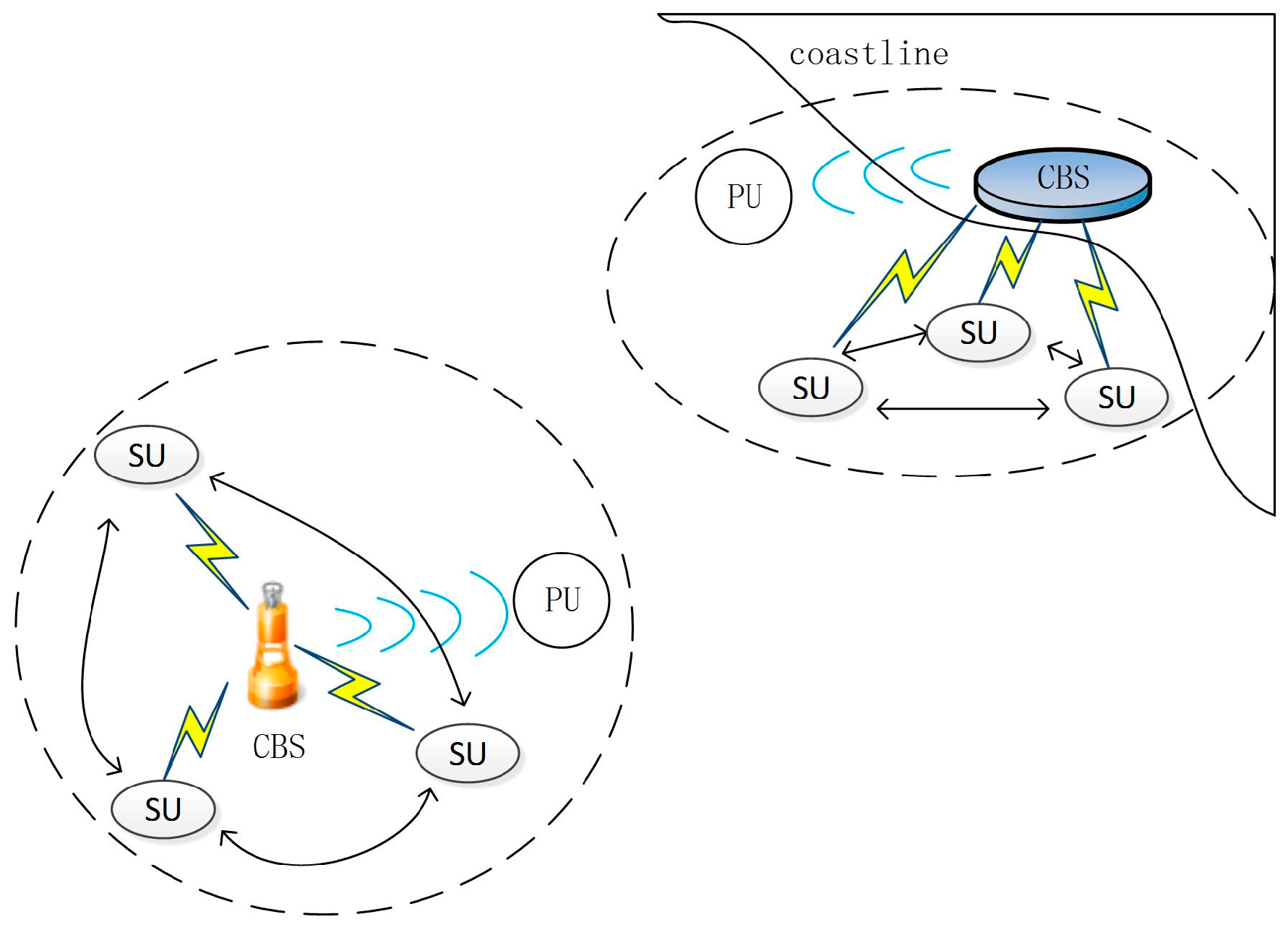
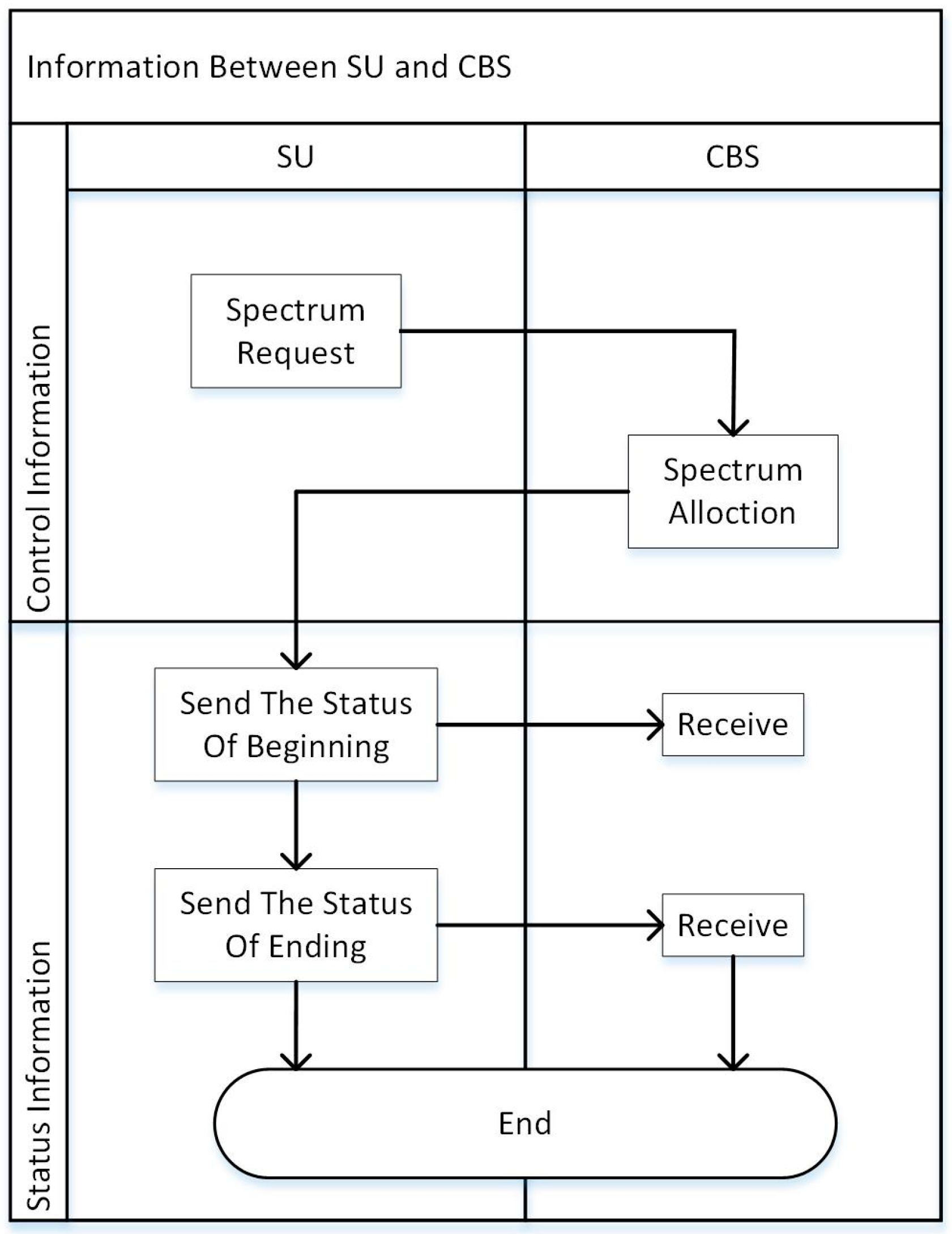
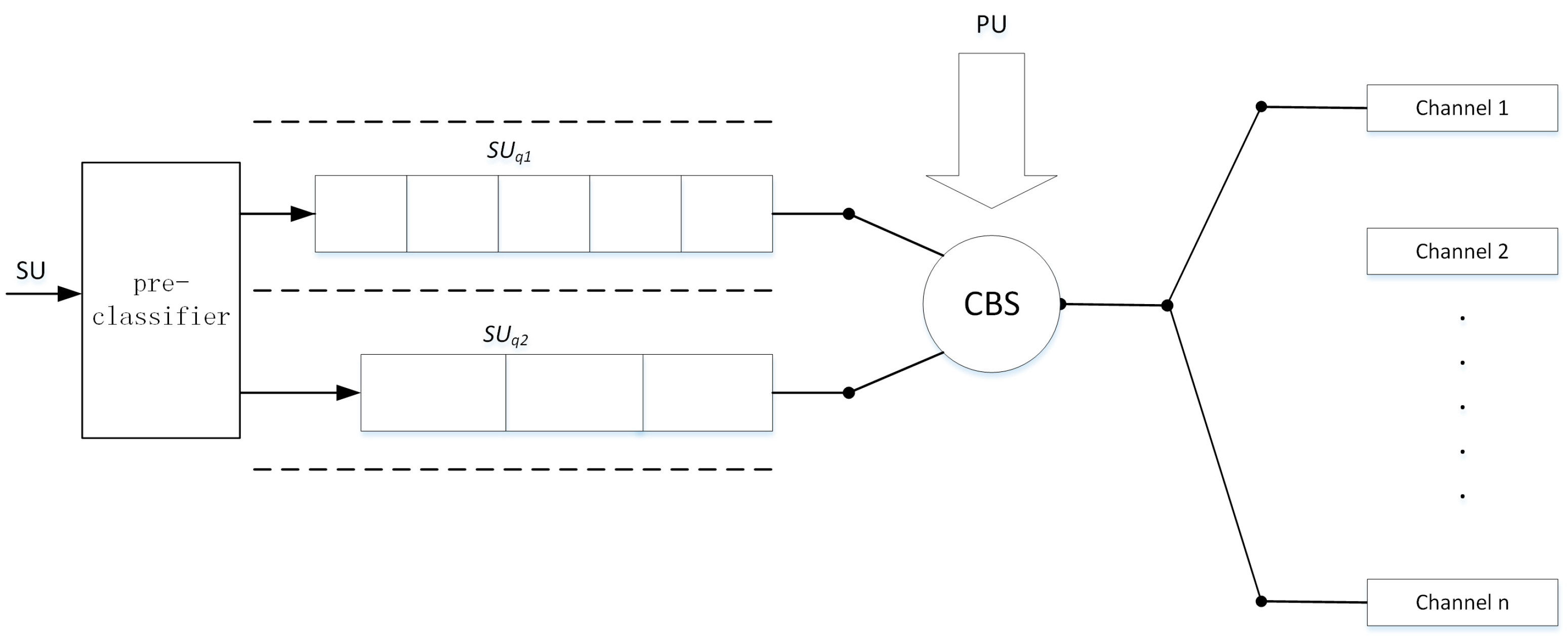
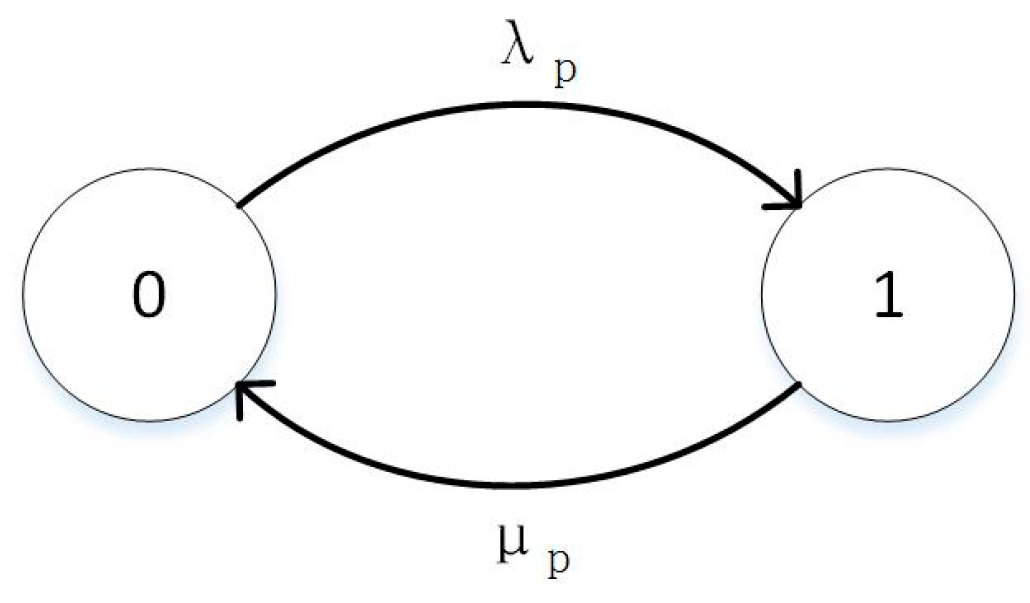
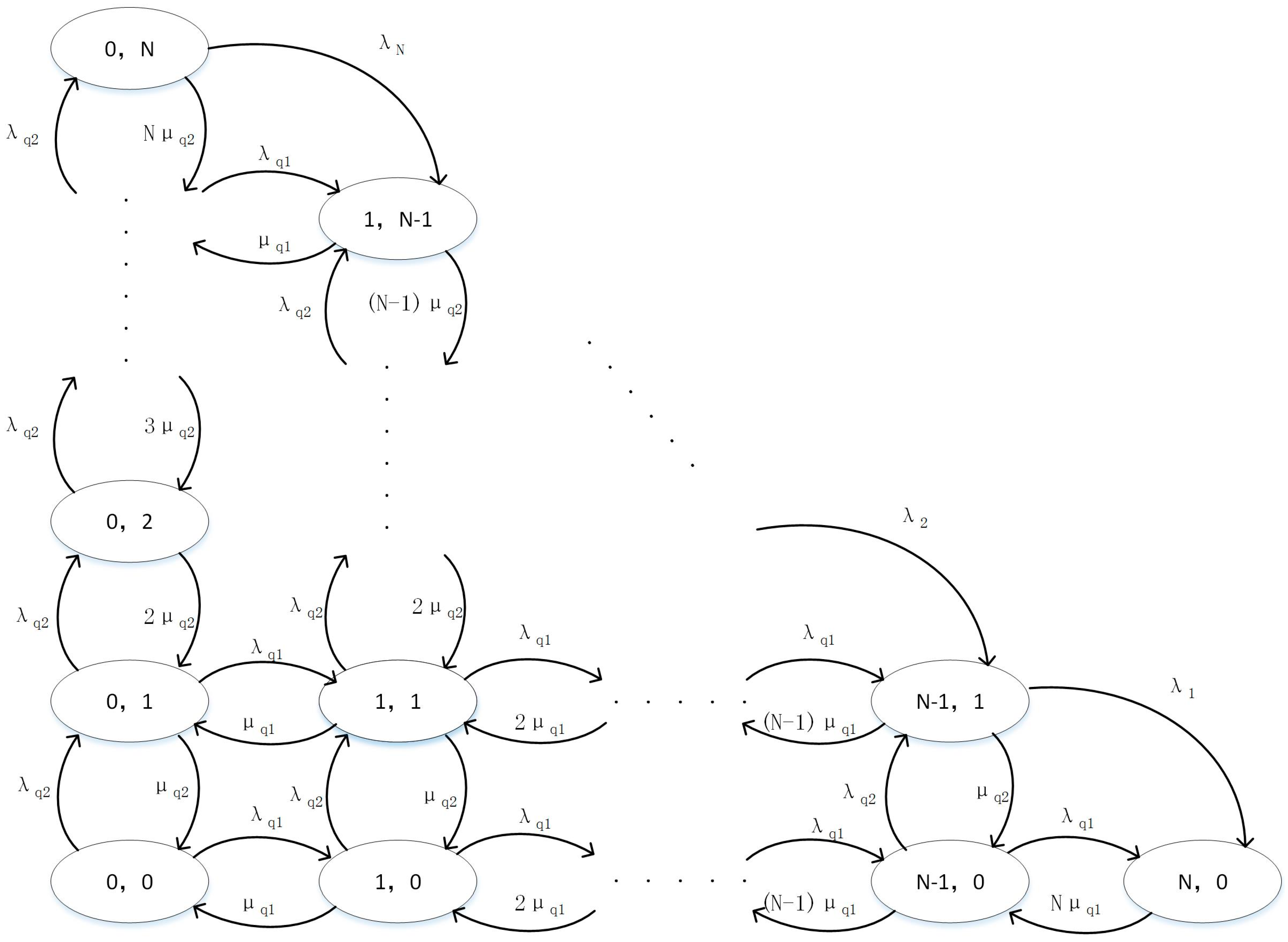
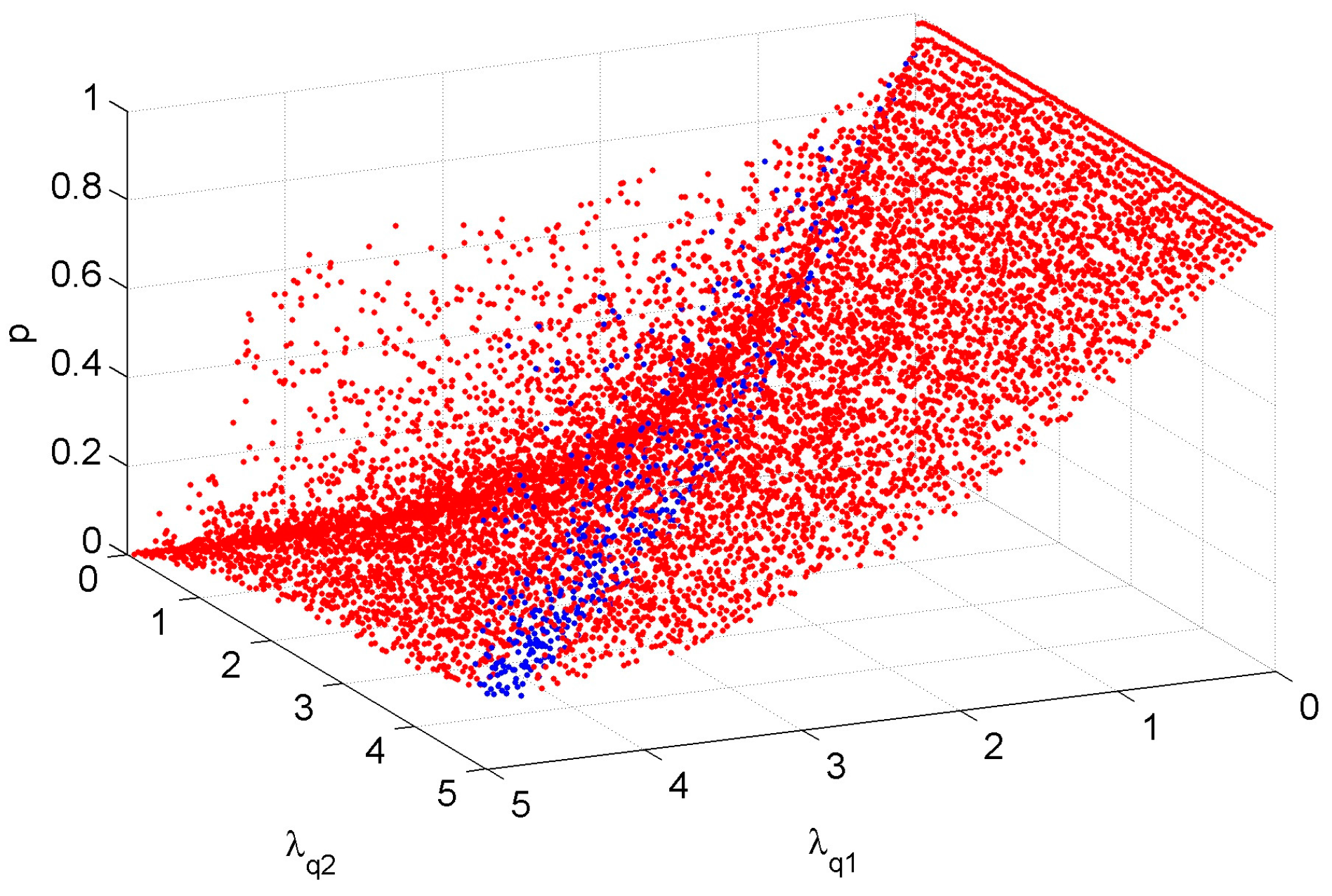
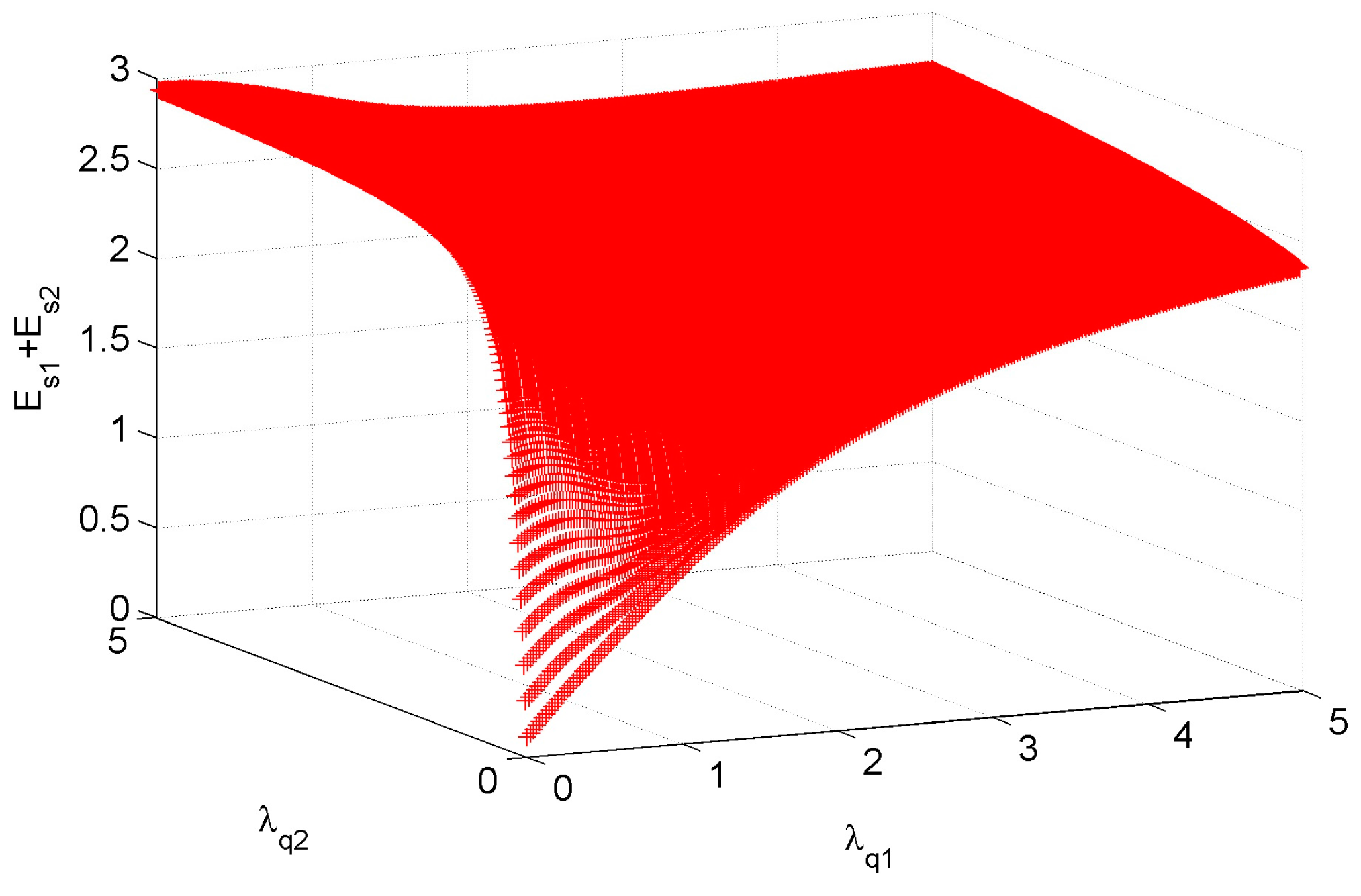
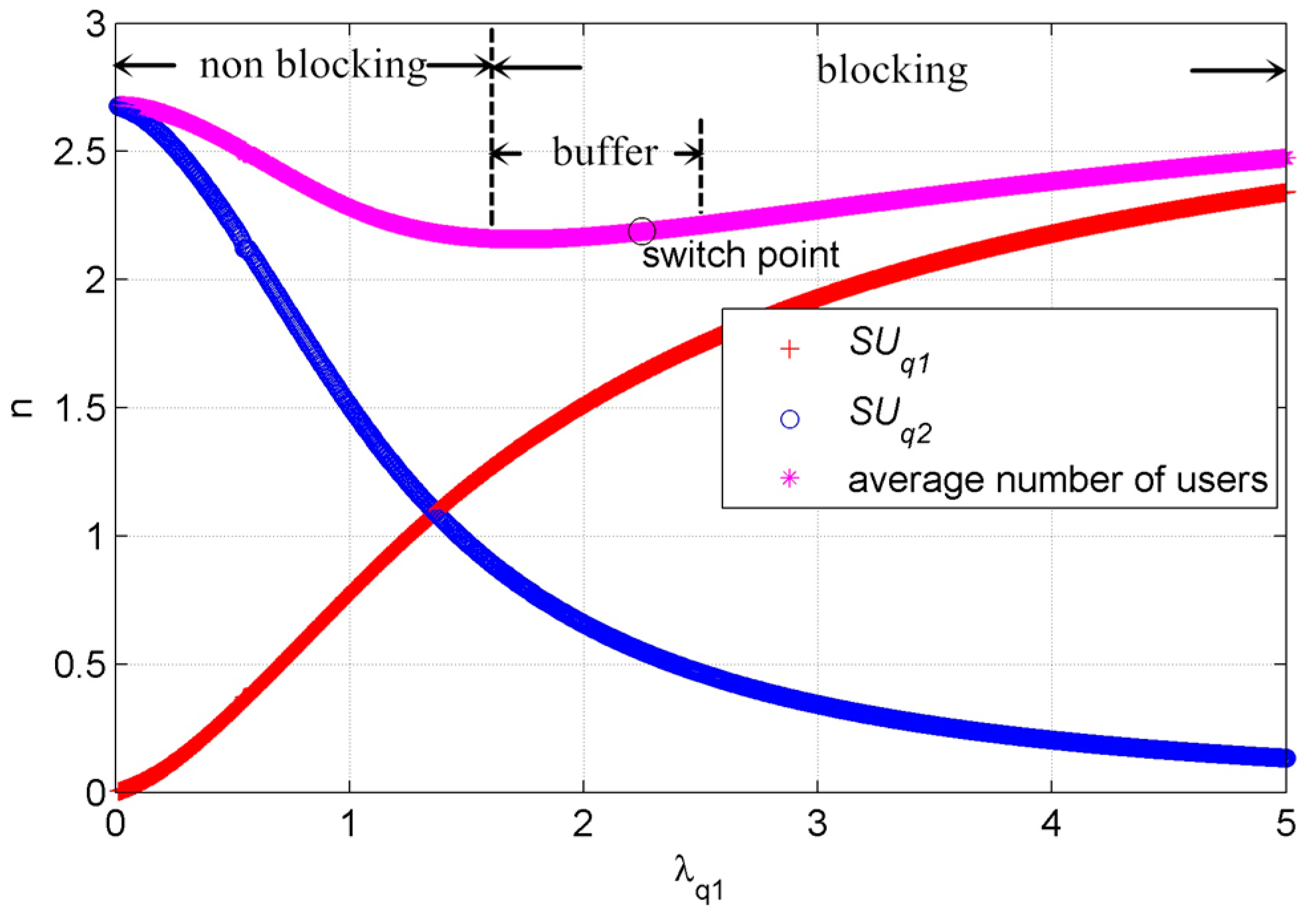
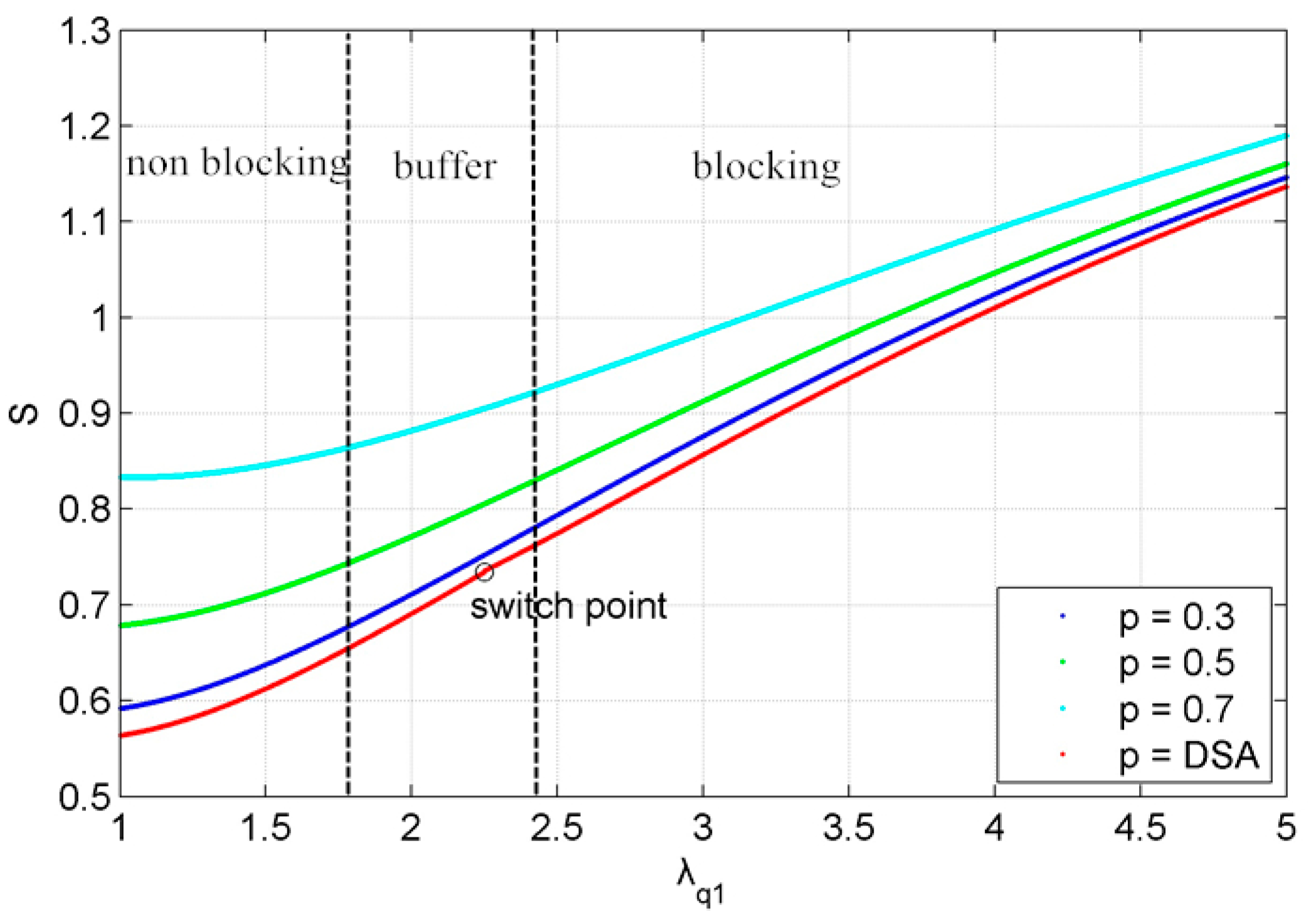
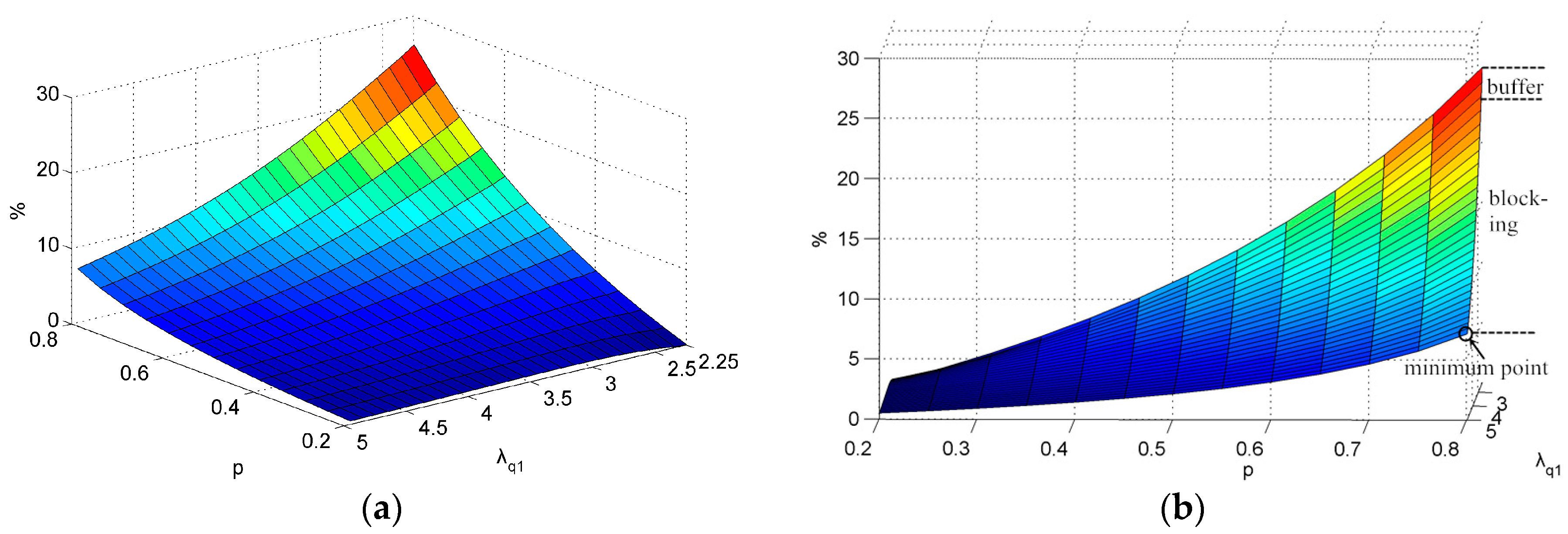
© 2017 by the authors. Licensee MDPI, Basel, Switzerland. This article is an open access article distributed under the terms and conditions of the Creative Commons Attribution (CC BY) license (http://creativecommons.org/licenses/by/4.0/).
Share and Cite
Zhang, J.; Yang, J.; Zhang, Y.; Zhang, S. A Dynamic Spectrum Allocation Algorithm for a Maritime Cognitive Radio Communication System Based on a Queuing Model. Information 2017, 8, 119. https://doi.org/10.3390/info8040119
Zhang J, Yang J, Zhang Y, Zhang S. A Dynamic Spectrum Allocation Algorithm for a Maritime Cognitive Radio Communication System Based on a Queuing Model. Information. 2017; 8(4):119. https://doi.org/10.3390/info8040119
Chicago/Turabian StyleZhang, Jingbo, Jianyu Yang, Yiying Zhang, and Shufang Zhang. 2017. "A Dynamic Spectrum Allocation Algorithm for a Maritime Cognitive Radio Communication System Based on a Queuing Model" Information 8, no. 4: 119. https://doi.org/10.3390/info8040119




